Lenovo ThinkPad P17 (17″) Mobile Workstation Benchmarks
In our benchmark session, we wanted to get some sense of house the notebook performs.
AIDA64 Memory Test
AIDA64 memory bandwidth benchmarks (Memory Read, Memory Write, and Memory Copy) measure the maximum achievable memory data transfer bandwidth.
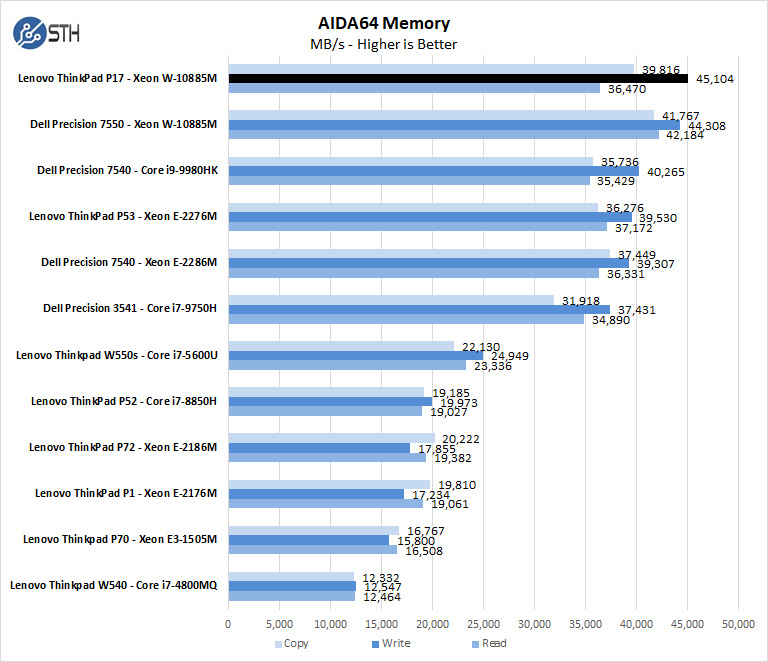
Lenovo ThinkPad P17 (17″) Mobile Workstation has two sticks of memory installed, which gives a significant boost to performance. We recommend installing at least two sticks of memory when configuring your Lenovo ThinkPad P17 so that one gets dual-channel memory operation.
AIDA64 GPGPU
These benchmarks are designed to measure GPGPU computing performance via different OpenCL workloads.
- Single-Precision FLOPS: Measures the classic MAD (Multiply-Addition) performance of the GPU, otherwise known as FLOPS (Floating-Point Operations Per Second), with single-precision (32-bit, “float”) floating-point data.
- Double-Precision FLOPS: Measures the classic MAD (Multiply-Addition) performance of the GPU, otherwise known as FLOPS (Floating-Point Operations Per Second), with double-precision (64-bit, “double”) floating-point data.
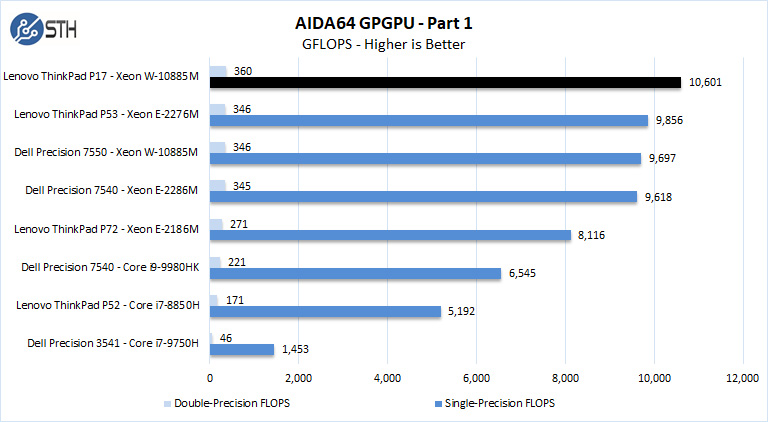
The next set of benchmarks from AIDA64 are:
- 24-bit Integer IOPS: Measures the classic MAD (Multiply-Addition) performance of the GPU, otherwise known as IOPS (Integer Operations Per Second), with 24-bit integer (“int24”) data. This particular data type defined in OpenCL on the basis that many GPUs are capable of executing int24 operations via their floating-point units.
- 32-bit Integer IOPS: Measures the classic MAD (Multiply-Addition) performance of the GPU, otherwise known as IOPS (Integer Operations Per Second), with 32-bit integer (“int”) data.
- 64-bit Integer IOPS: Measures the classic MAD (Multiply-Addition) performance of the GPU, otherwise known as IOPS (Integer Operations Per Second), with 64-bit integer (“long”) data. Most GPUs do not have dedicated execution resources for 64-bit integer operations, so instead, they emulate the 64-bit integer operations via existing 32-bit integer execution units.
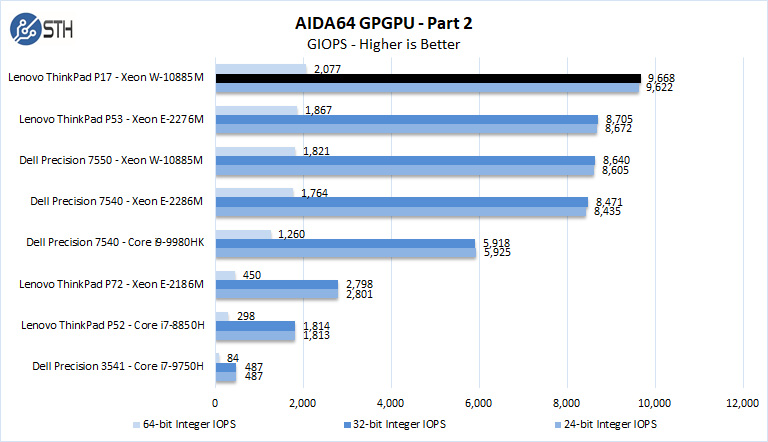
The Nvidia Quadro RTX 5000 is a high-end mobile Quadro featuring the Turing-based Quadro RTX processor, which adds a significant performance boost.
Cinebench R15
Cinebench is a real-world cross-platform test suite that evaluates your computer’s performance capabilities. The test scenario uses all of your system’s processing power to render a photorealistic 3D scene. This scene makes use of various algorithms to stress all available processor cores. You can also run this test with a single core mode to give a single-core rating.
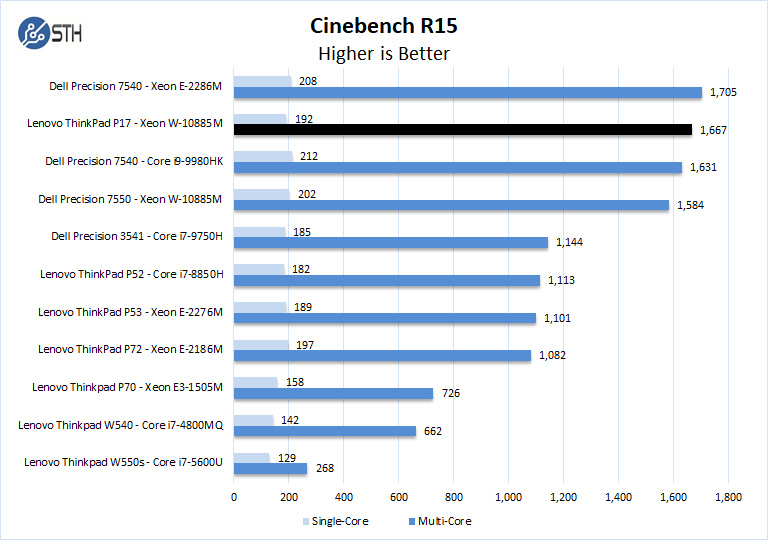
The Xeon W-10885M shows excellent performance for a mobile workstation in Cinebench R15 with a slight boost to multi-core scores. We do see the start of thermal throttling with this test and further tests to come. With a Mobile Workstation of this size, thermals can be an issue when under heavy loads.
Geekbench 4
Geekbench 4 measures the compute performance of your GPU using image processing to computer vision to number crunching.
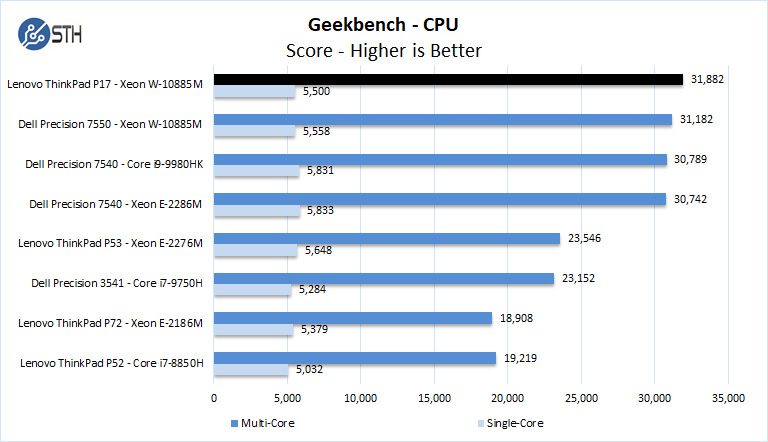
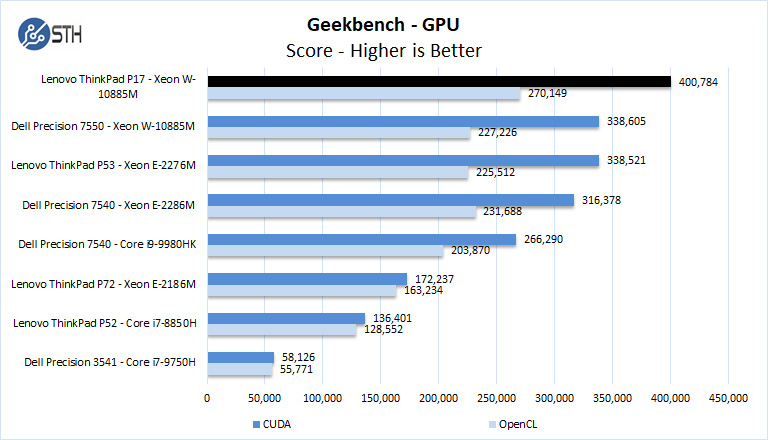
Overall the Lenovo ThinkPad P17 (17″) Mobile Workstation shows solid results; the Nvidia Quadro RTX 5000 is very strong in OpenCL and CUDA benchmarks.
LuxMark
LuxMark is an OpenCL benchmark tool based on LuxRender.
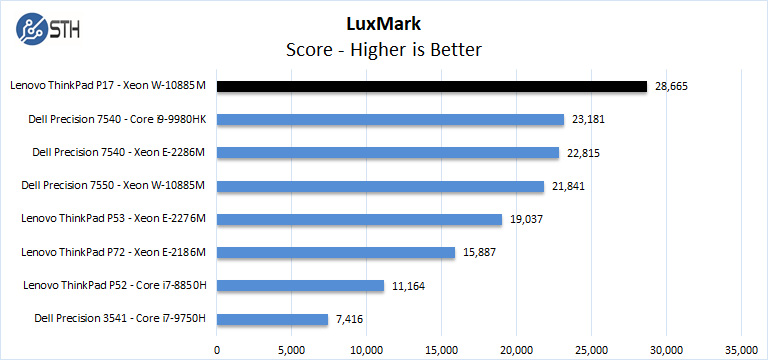
The Lenovo ThinkPad P17 (17″) Mobile Workstation came with an NVIDIA Quadro RTX 5000, a top performer in LuxMark.
Let us move on and start our testing with graphics-related benchmarks.

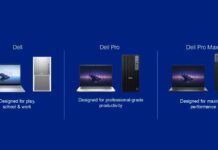

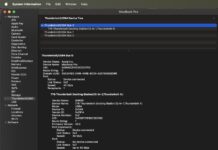
Excellent review!! Your CrystalDiskMark scores are dead-on the same as what I get with a single Kioxia XPG6 512GB (what the unit came with-contemplating storage upgrades at the moment). I’m thinking RAID isn’t set up correctly in your unit? My hardware specs aren’t anywhere near as impressive, nonetheless, for reference; I7-10750H, Quadro T2000, 32GB memory.
Although I’m going strictly from memory, as I wiped out my benchmark folder on a reinstall by not paying attention (oops), but I do recall using Peak Performance NVME mode in CDM, with numbers topping out at just under 32xx and just over 29xx.. I don’t recall my random 4k or other results being as impressive as what you obtained though, plus I just notice the size of the c: volume as 3.8TB, so I have to retract my earlier thoughts about the raid not being set up correctly… That just seems odd that the peak numbers would match a single drive of the same manufacturer/series so closely. I do recall those numbers very clearly… Will run CDM again just out of curiosity..
It’s a complete shame that Intel has such an iron grip on OEMs like Lenovo. Objectively inferior processors are going into “professional” machines now simply due to forced brand loyalty. Ryzen 4000 or 5000 series chips in these laptops would make them a far, far more compelling offering if paired alongside RTX 3080s for premier graphics performance. The sheeple will, of course, continue to recommend and to buy these units for the foreseeable future even as the performance and efficiency disparities between AMD and Intel grow. I’ll be skipping Lenovo’s offering here, yet again.
I liked the keyboard action and feedback response from my old Lenovo laptop, but did not like how the keys were arranged. That is because after using a full size keyboard, would often strike the delete, not the backspace key, by accident, and sometimes there was no going back.
Josiah,
I don’t think that the CPU has much impact on the GPU performance and hasn’t for a very long time.
I’d save my criticism for nvidia needing to do more with storage DMA and laptop vendors needing to afford the space to install PLP Optane, before I really feel like I should start bleating.
The fact is though, that possibilities like that definitely exist for the horizon, and until then I am buying laptops with a unusual cadence because covid brought forward so many usability and performance based usability requirements earlier than we planned for a general horsepower uplift, and just as I’m writing this maybe what I have said is a reason why a lot of people are feeling underwhelmed by the latest offerings, right now.
I’m using a two year old ThinkPad P71 mobile workstation with max specs from that time: Xeon E3-1515M V6 (Kaby Lake QuadCore), 32GB DDR4 ECC, nVidia Quadro P5000 16GB VRAM (nVidia Pascal generation, performance equals nearly a GTX1080), UHD 4K IPS display.
To my surprise Lenovo preinstalled Windows in the Windows 10 Pro for Workstations edition (Kernel features more functions from the Windows Server editions).
Hello and thanks for the review! I have a question about the display. How much of srgb/argb does that display cover? I figured since lenovo is not bragging about 100% argb, it just doesn’t? Thx.